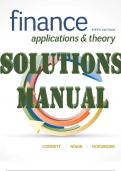Exam (elaborations)
Finance: Applications and Theory 5th Edition by Marcia Cornett, Troy Adair & John Nofsinger | SOLUTIONS MANUAL
SOLUTIONS MANUAL for Finance: Applications and Theory 5th Edition by Marcia Cornett, Troy Adair & John Nofsinger. ISBN-13 978-6. TABLE OF CONTENTS: Chapter 1 Introduction to Financial Managem ent Chapter 2 Reviewing Financial Statements Chapter 3 Analyzing Financial Statements Chapter 4 Time Value ...
[Show more]



